Participation from all walks of life: How Conservation Volunteers are the strength behind our stewardship work
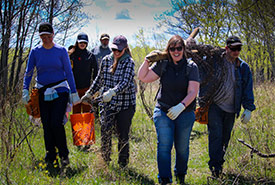
Red Deer fence pull event, AB (Photo by Sasha Makheneva/NCC staff)
As songbirds chirp away and we embrace longer hours of sunlight each day, many of us from coast to coast begin to feel the weight of winter lifting and are eager to spend more time in nature. At the Nature Conservancy of Canada (NCC), we are equally excited to welcome new and familiar faces to our Conservation Volunteers program and see you on the land, sharing stories and laughter over some good work.
It goes without saying that the power of partnership and collective efforts have remarkable impact. Since 2017, over 8,600 volunteers donated more than 37,400 hours to help our stewardship activities and projects, contributing to making nature a thriving place for all.
We are grateful for their dedication and recognize the amazing work that our volunteers have accomplished in the past decade and beyond, from coast to coast. Below are some impactful stories from across the country.
Atlantic: Cleaning the East Coast
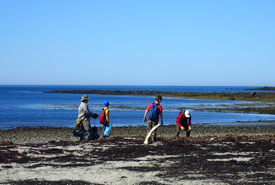
Shoreline cleanup on Brier Island, NS (Photo by NCC)
If there is one thing that unites Atlantic Canada, it’s the Atlantic Ocean and its beautiful coasts. The global issue of garbage in our ocean has been a topic of major concern in the last decade, with high-profile and award-winning documentaries like "A Plastic Ocean" highlighting the enormity of this issue.
Canada has the longest coastline in the world, a significant amount of which is on the East Coast. Over the last decade, Conservation Volunteers in the Atlantic provinces have been tirelessly cleaning up coastal areas to help protect these habitats from the dangers that garbage can cause to wildlife and people. Several shoreline cleanups are held every year, and the impact that volunteers have is enormous, sometimes removing more than 50 garbage bags worth of trash! While much of our work is land-based, NCC volunteers are also helping keep our coastal environments clean and healthy for future generations.
Quebec: Why did the turtle cross the road?
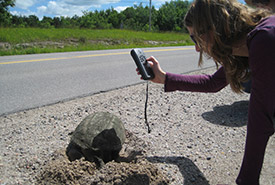
Snapping turtle, data collection (Photo by NCC)
Conservation Volunteers in Quebec are finding out! In Canada, animals dying from collisions with vehicles is a major problem, but generally when we think of this, we picture large mammals, like moose and deer. Unfortunately, many smaller animals, like turtles, also fall victim.
Turtles are slow to reproduce and when they do, many of their hatchlings do not make it to adulthood. In 2017, NCC in Quebec launched a turtle monitoring project called the Carapace Project, where citizens can note their turtle sightings to help build a picture of turtle movements and patterns. The information captured through this project provides us with an idea of where these populations are concentrated and where they could be at risk from human hazards. Understanding where turtles cross the road or where they are victims of road accidents is very important in informing conservation actions like building turtle crossings under roadways in high-risk areas to provide a safe place for turtles and other small wildlife to cross. This effort to protect turtles wouldn’t be possible without the help of community scientists sharing their observations.
Learn more about NCC’s efforts to help turtles on this NatureTalks podcast episode.
Ontario: Counting critters at the Carden Alvar
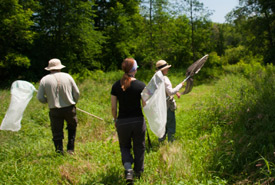
Volunteers searching for dragonflies at Carden Alvar, ON (Photo by Leanne Gauthier-Helmer)
Over the last several decades, Conservation Volunteers have played an essential role in shaping our understanding of butterfly and dragonfly populations in Ontario. Volunteers have been catching and identifying species to record their numbers in the Carden Alvar, a rare ecosystem characterized by shallow soils over limestone. During an average counting event, volunteers have counted 2,815 butterflies (with the record being 8,327) or 1,365 dragonflies. The high number of insects recorded combined with the long-term nature of these events provide us with enough data to understand their population and range trends. Butterflies and dragonflies are also indicator species, meaning their numbers can tell us a lot about changes in their ecosystem. This data can also show us if some species are increasing their range northward due to climate change. This knowledge can better prepare conservation planning with an understanding of what our future landscape might need to look like to accommodate these changes.
With new technology, people can even continue to contribute valuable information from anywhere! NCC’s properties in Ontario, including Carden Alvar, have been added into iNaturalist, a community science app that allows anyone to contribute to science anytime by uploading their sighting of a species.
Hear more about the Carden Alvar in this episode of the NatureTalks podcast.
Manitoba: The two-way street of nature-based education in Manitoba
The impact of the Conservation Volunteers program goes beyond NCC projects; it also impacts those volunteering. This is especially true in Manitoba, where volunteering supplements education and provides youth with the opportunity to get hands-on experience helping the environment. Programming ranges from in-class presentations about nature to field trips where students volunteer at NCC properties and help us work toward achieving our conservation objectives.
The impact and partnerships of nature stewardship-based education programming has led to exciting projects, like our partnership with the Waywayseecappo Off-Campus School. Built on a combination of western science and Indigenous Traditional Knowledge, this program is giving students a chance to get school credits while learning about the land and species near their community while helping achieve conservation objectives. These types of programs can have a massive impact in connecting youth with nature and inspiring future stewards of the environment.
Saskatchewan: Making Canada’s living skies more bird-friendly
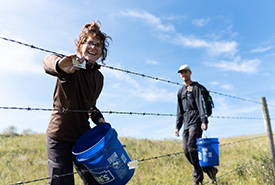
Volunteer placing fence clip, SK (Photo by Michael Bell)
When you picture nature in Saskatchewan, you might think of a rolling sea of grasslands and vast open skies — the perfect place for birds. Unfortunately, the grasslands are one of the most endangered ecosystems in the world, and its birds are one of the fastest declining species in North America. Over the last decade, Conservation Volunteers have played an essential role in helping our grassland birds. The addition of man-made objects, like fences, to the prairie landscape can unfortunately create new hazards for the birds that live there. In areas where this infrastructure can’t be removed, NCC and volunteers are exploring innovative ways to minimize these hazards for birds. One example of this work is marking fences with vinyl tags so that low-flying birds, like the endangered greater sage-grouse, don’t fly into them.
At NCC’s Wideview property, 12 kilometres of fences have been marked, with many more to come. Another example is using up-cycled materials to prevent grassland songbirds from falling into hollow fence posts. More than 5,000 of these fence caps have been installed at Old Man on His Back Prairie and Heritage Conservation Area. The strides made in our work to protect our prairie birds while setting an example of creative solutions for coexisting with nature wouldn’t be possible without the help of volunteers.
Check out this episode of the "Nature of Things" featuring NCC’s grassland properties.
Alberta: Alliances and appetizers in Alberta
Across Canada, a long and hard-fought battle is raging with invasive species. Like any other battle, this fight against invasive species can be aided with creative tactics and allies. In Alberta, NCC has partnered with The Lee Nature Sanctuary Society to remove invasive weeds from The Clifford E. Lee Nature Sanctuary, a property owned and managed by Ducks Unlimited Canada. Conservation Volunteers have been integral to this battle since 2006, but pulling weeds is no easy task and one that is quite deserving of a good snack at the end. This is especially true when the weed being fought is creeping thistle; its seeds can lie dormant and undetected and spring into a new plant after 20 years. This battle led to the creative tactic of using the pulled weeds as a tasty fuel for volunteers, ensuring that they get the nutrients they need to keep on fighting another day. Not only are these snacks tasty, but they are also highly nutritious and packed with vitamins, minerals and antioxidants. This tradition ensures that volunteers get a workout and a free superfood boost all the while improving habitat for native species. Invasive plants might not help native ecosystems, but they can sure help our bodies!
Looking to the future
There is plenty of impact to be made in this next decade, which has been declared the Decade on Ecosystem Restoration by the United Nations. Conservation is becoming ever more important, and the role of volunteers will continue to grow. We look forward to seeing you out in the field again.
Want to join us and many other like-minded people in nature?
Sign up for a Conservation Volunteers event near you.






